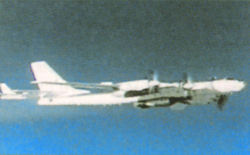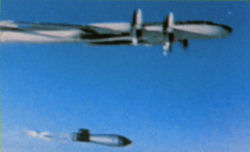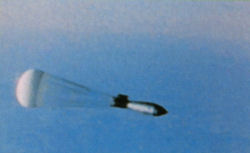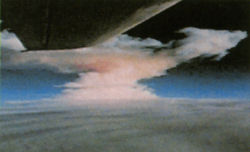New York City


A 150 kiloton bomb constructed by terrorists is detonated in the heart of Manhattan, at the foot of the Empire State Building. The bomb goes off without warning at noon time. It's a clear spring day with a breeze to the east.
Assumptions
- There is no warning. The population has not been evacuated nor sought shelter. Both measures could reduce casualties.
- There is clear weather, with visibility of 9 miles (16 km).
- This is an isolated attack, leaving the rest of the country free to respond.
- A large percentage of the day time population is outside - 25%.
- The daytime population density is roughly uniform and about 125,000 per square mile.
- The shock wave will spread out uniformly in all directions, being minimally affected by structures.
1 Second After Detonation




Blast Wave
At the end of the first second, the shock wave will have an overpressure of 20 psi. at a distance of four tenths of a mile from ground zero. Even the most heavily reinforced steel and concrete buildings will be destroyed. These buildings include the Empire State Building, Madison Square Gardens, Penn Central Railroad Station and the New York Public Library. Most of the material that comprises these buildings will remain and pile up to a depth of hundreds of feet in places, but nothing inside this ring will be recognizable.
Casualties
This circle contains a daytime population of roughly 75,000. There will be no survivors. Those caught outside will be exposed to the full effects of the blast, including severe lung and ear drum damage and exposure to flying debris. Those in the direct line of sight of the blast will be exposed to a thermal pulse in excess of 500 cal/sq.cm., causing instant death. Those inside, though shielded from some of the blast and thermal effects, will be killed as buildings collapse.
Fireball
The fireball will have a maximum radius of 1,023 feet (0.2 miles). However, the blast effects will greatly outweigh any direct thermal effects due to the fireball.
4 Seconds After Detonation


Blast Wave
An overpressure of at least 10 psi. extends out for 1 mile. Concrete and steel reinforced commercial buildings will be destroyed or severely damaged out to the edge of this ring. The few buildings that remain standing on the outside edge of this ring will have their interiors destroyed. Though the thermal pulse is intense enough to ignite most materials, the shock wave will likely extinguish most fires in this ring. Landmarks affected by the blast at this distance include the Chrysler Building, Rockerfeller Center, the United Nations, and four hospitals. All of these buildings will be totally destroyed or so severely damaged that they will be unusable and will have to be demolished in the clean-up.
Casualties
Most people inside buildings will be killed by flying debris or die as the buildings collapse. Almost all those outside and not in the direct line of sight of the blast will receive lung and ear drum injuries to varying degrees. Those in the direct line of sight will be killed instantly by the thermal pulse. Fatalities are estimated at 300,000 with many of the remaining 100,000 receiving some form of non-fatal injury. Those people in this ring making use of New York's subway system will escape with few injuries, though they may be trapped for days by debris blocking entrances and exits.
6 Seconds After Detonation


Blast Wave
In the next two seconds the shock wave moves out another half mile, extending the destruction out to a 1.5 mile radius. The overpressure has dropped to 5 psi. at the outer edge of this ring, which covers an area of 4 square miles. Reinforced structures are heavily damaged and unreinforced residential type structures of brick and wood are destroyed. Affected structures include Carnegie Hall, the Lincoln Center and the Queensboro Bridge. All the named structures are near the outside edge of this ring. All windows in these structures will be shattered and many interior walls will collapse.
Casualties
This ring contains 500,000 people during the day. About 190,000 will be killed inside buildings by flying debris. This is roughly half of the assumed indoor population. The other 190,000 will suffer varying degrees of injuries. Most of those outside and not in the direct line of sight of the explosion will escape direct injury from the blast, but may be injured by flying objects. The thermal pulse is still sufficiently intense (40 cal/sq.cm.) to kill anyone in the direct line of sight; approximately 30,000. Those people fortunate enough to be under ground will escape with no injuries. The total number of injured will be approximately 220,000, leaving roughly 60,000 uninjured.
Thermal Effects
This region contains the most severe fire hazard, since fire ignition and spread are more likely in partly damaged buildings than in completely flattened areas. Perhaps 5% of the building would be initially ignited, with fire spread to adjoining buildings highly likely. Fires will continue to spread for 24 hours at least, ultimately destroying about half the buildings.
10 Seconds After Detonation


Blast Wave
This band extends out to a 2.5 mile radius and has an overpressure at the outside edge of 2 psi. Reinforced structures will receive varying amounts of damage, with those buildings at the edge being almost completely undamaged. Wood and brick buildings will receive moderate amounts of initial damage, with the damage becoming less significant at the outside edge of the ring.
Casualties
An estimated 235,000 people (15%) will be fatalities in this ring, with another 525,000 injured to varying degrees. No injuries will be due directly to the blast overpressure. However, the thermal pulse will still be sufficient to kill or incapacitate those not indoors or otherwise protected. The degree of injury from the thermal pulse will depend greatly on clothing and skin color. Darker clothing and skin will absorb more of the energy, giving a more severe burn. The material type and thickness will also determine the severity of burns from the thermal pulse.
Thermal Effects
The possibility of delayed damage due to fire is very real in this band. The energy in the thermal pulse will still be sufficient to start combustible materials on fire, yet the overpressure and accompanying wind will be less likely to put out these fires. If only a small percentage of the buildings start on fire many may be damaged as the fire spreads out of control since the capability to fight fires will be non-existent. It may be 24 hours or more before the resources are available to even begin to fight fires.
16 Seconds After Detonation


Blast Wave
This band extends out for almost 4 miles and has an overpressure of 1 psi. at its outside edge. At the inner edge there will be light to moderate amounts of damage to unreinforced buildings of brick and wood. Reinforced structures and commercial buildings will receive light damage at most. This band extends out to the site of the former World Trade Center and the Statue of Liberty in the south, across the East River into Queens in the east, and across the Hudson River to New Jersey.
Casualties
Though this ring covers an additional 30 square miles, much of this area is over water or less densely populated areas. The affected population in this ring is estimated to be 500,000. There will be almost no fatalities in this ring and only a small percentage, roughly 30,000, will receive injuries from the thermal pulse. Flashblindness and permanent retinal injuries from the blast will extend out beyond 20 miles. Since this is a ground level explosion, the number of people who will be looking in the direction of the blast and have a clear view, will be much less than if the explosion had taken place several thousand feet above the city.
Long-Term Fallout Pattern


Radioactive Fallout
A surface explosion will produce much more early fallout than a similarly sized air burst where the fireball never touches the ground. This is because a surface explosion produces radioactive particles from the ground as well as from the weapon. The early fallout will drift back to earth on the prevailing wind, creating an elliptical pattern stretching from ground zero out into Long Island. Because the wind will be relatively light, the fallout will be highly concentrated in the area of Manhattan just to the east of the blast. Predicting levels of radiation is difficult and depends on many factors like bomb size, design, the ground surface and soil type.
Fallout Effects
5-20 (Dose-rem): Possible late effects; possible chromosomal damage.
20-100 (Dose-rem): Temporary reduction in white blood cells.
100-200 (Dose-rem): Mild radiation sickness within a few hours: vomiting, diarrhea, fatigue; reduction in resistance to infection.
200-300 (Dose-rem): Serious radiation sickness effects as in 100-200 rem and hemorrhage; exposure is a Lethal Dose to 10-35% of the population after 30 days (LD 10-35/30).
300-400 (Dose-rem): Serious radiation sickness; also marrow and intestine destruction; LD 50-70/30.
400-1000 (Dose-rem): Acute illness, early death; LD 60-95/30.
1000-5000 (Dose-rem): Acute illness, early death in days; LD 100/10.
Recovery
In this simulated attack we have assumed that New York is the only city attacked and that there is nothing to prevent state and federal agencies from concentrating their resources on bringing aid to the devastated area. Though the cleanup and decontamination of the most severely damaged and radioactive areas would take years, much immediate aid could be obtained from the outside.
Access
Manhattan is an island connected to the rest of New York and New Jersey by tunnels and bridges. Many of these access points will be affected to some degree by the blast. The Lincoln and Queens Midtown Tunnels are both in the 10 psi. ring and would likely be damaged or blocked by debris. The Queensboro Bridge is in the 5 psi. ring and would likely be damaged. The remaining tunnels and bridges all fall in the 2 or 1 psi. rings and might receive some light damage but would likely be usable. The rescue effort from outside would be further hampered by people trying to flee the area. In general, help from the outside would be slow in coming.
Medical Effects
With almost 900,000 people injured to various degrees, the task of caring for the injured will be beyond the ability of the medical system to respond. All but one of Manhattan's large hospitals lie inside the 5 psi. ring and would be completely destroyed. There aren't enough empty hospital beds in all of New York and New Jersey for even the most critically injured. The 1 psi. ring alone has an estimated 30,000 burn victims that will need specialized care. The entire country has a total of 3000 beds in burn centers. In the days to follow it is likely that many of the injured will die from lack of any medical care.
Utilities
Most of Manhattan will be without utilities (electricity, gas, water, sewage). Out to the edge of the 2 psi. ring, damaged buildings and the resulting debris will make repairs very difficult, if not impossible, for several weeks. It is likely that the stress to the power system will temporarily knock out power to an area much larger than that directly affected by the blast.
Rescue and Recovery
Transportation of the injured and the ability to bring in the necessary supplies, people and equipment will be dependent on the condition of the tunnels and bridges that connect Manhattan to New York and New Jersey. As discussed in Access, these points will be blocked or damaged to varying degrees, except at the far north and south tips of the island. The main train station lies in the 10 psi. ring and would be completely destroyed. Once access is established then true rescue work can begin.
It is likely that many tens of thousands of people would become homeless. Creation of temporary shelter would be among the first recovery tasks after all the trapped and injured had been found and cared for. True recovery for New York would take many years. Some areas would remain dangerously radioactive and would have to be cleaned up at tremendous cost or be abandoned for many years to come. Even without the radioactivity it is likely that New York City would never fully recover to its present status as one of the country's leading financial and cultural centers.

Summary
While this simulation of a 150 kiloton nuclear explosion contains many assumptions, and the uncertainty associated with any of the estimates is large, a number of points stand out:
- 20 square miles of property destruction ( 2 psi.).
- Eight hundred thousand killed, nine hundred thousand injured.
- Additional damage from post blast fires.
- Coordinated national rescue and recovery effort necessary.
Source: http://www.atomicarchive.com
See Also: One megaton surface burst on Detroit & Broken Arrow in San Francisco.





